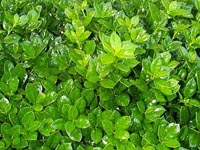Resource Library
Plant of the Week: Holly, Burford
The University of Arkansas System Division of Agriculture does not promote, support or recommend plants featured in "Plant of the Week." Please consult your local Extension office for plants suitable for your region.
Plant of the Week
Burford Holly
Latin: Ilex cornuta 'Burfordii'

The Burford holly has lost some of its luster in the past few years as the Southern
landscape has continued its drift from being more formal and controlled to more informal
and naturalistic in appearance.
Although Burford’s day has largely passed at the nursery, we still see many of these
15- to 20-foot tall, rounded shrubs in the landscape. They become especially apparent
this time of year as their heavy crop of pea-size berries turn red. Unlike most hollies,
Burford holly does not require a male for pollination to get good fruit set.
Burford holly is a bud sport of the thorny-leafed Chinese holly that was found in
the early 1900s by Thomas Burford, the superintendent of Atlanta’s West View Cemetery.
The original plant was part of a shipment of seedlings received from the Department
of Agriculture, which had plant explorer Frank Meyer in China during much of the first
20 years of this century.
Burford differs in that it has only one spine at the end of the 2- to 3-inch long
leaf instead of the seven or nine inches common for the species. Its leaves are glossy
green all summer long but heavy fruit set will often rob some of the foliage of its
lustrous appearance in the winter.
I chose Burford holly for this week’s plant because I wanted to talk about the weather.
Don’t get me wrong, I love this protracted fall too, but it is beginning to get me
concerned. The Burford holly is winter hardy throughout the state, but it is still
bumping up against its northern hardiness limit. I have seen it freeze to the ground
once in the past 25 years over the northern third of Arkansas.
The damage from this kind of weather comes not from how cold it gets, but how fast
the cold weather arrives. The "Siberian Expresses" or "Blue Northers" drop the temperature
so fast that the plants are not able to properly harden off for winter and can be
killed. The most infamous storm of this type occurred on Armistice Day, Nov. 11, 1940,
when the temperature dropped over 70 degrees in less than 12 hours. The fall of 1940
had been mild with only scattered frosts as far north as the Canadian border, so when
kids went to school or duck hunters to their blinds that day they were woefully unprepared
for what was to arrive during the day. The storm arrived in midday in the upper Midwest
with a quick drop in temperature, snow and sleet, and a 50 mile an hour-plus wind.
Over 150 people died, mostly of exposure or drowning in the next 24 hours.
The plant loss from this massive storm is legendary in horticultural circles and
helped companies like the Stark Brothers select hard kinds of rootstocks that are
still used today. Burford holly, not so widely planted then as now, is just the kind
of plant that would have suffered from this rapid temperature drop. It is unlikely
that a comparable freeze would kill the plant completely, but it could freeze it to
the ground.
Burford hollies are ideal screen plants as long as one has room for their wide spread.
Unpruned, plants may be as wide as they are tall but they tolerate shearing well and
their size can be kept under control by cutting back as needed. Spring, just before
new growth begins, is the best time for severe pruning but light pruning can be done
at any season. Once established Burford tolerates dry weather without a fuss. Waxy
scale, especially in the southern part of the state, is the only problem that is common
with this tough shrub.
By: Gerald Klingaman, retired
Extension Horticulturist - Ornamentals
Extension News - November 19, 1999
The University of Arkansas System Division of Agriculture does not maintain lists of retail outlets where these plants can be purchased. Please check your local nursery or other retail outlets to ask about the availability of these plants for your growing area.